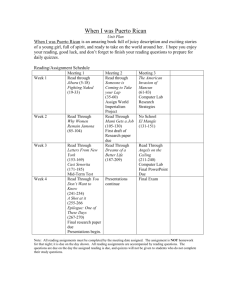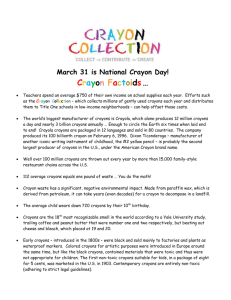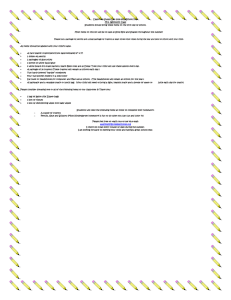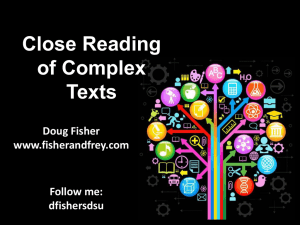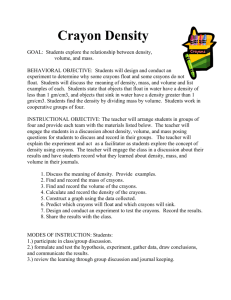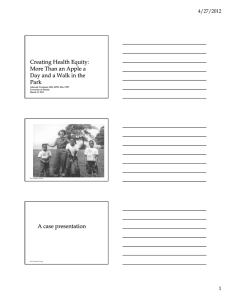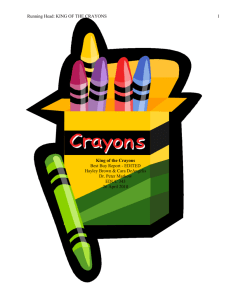I Believe in Crayola Crayons
advertisement
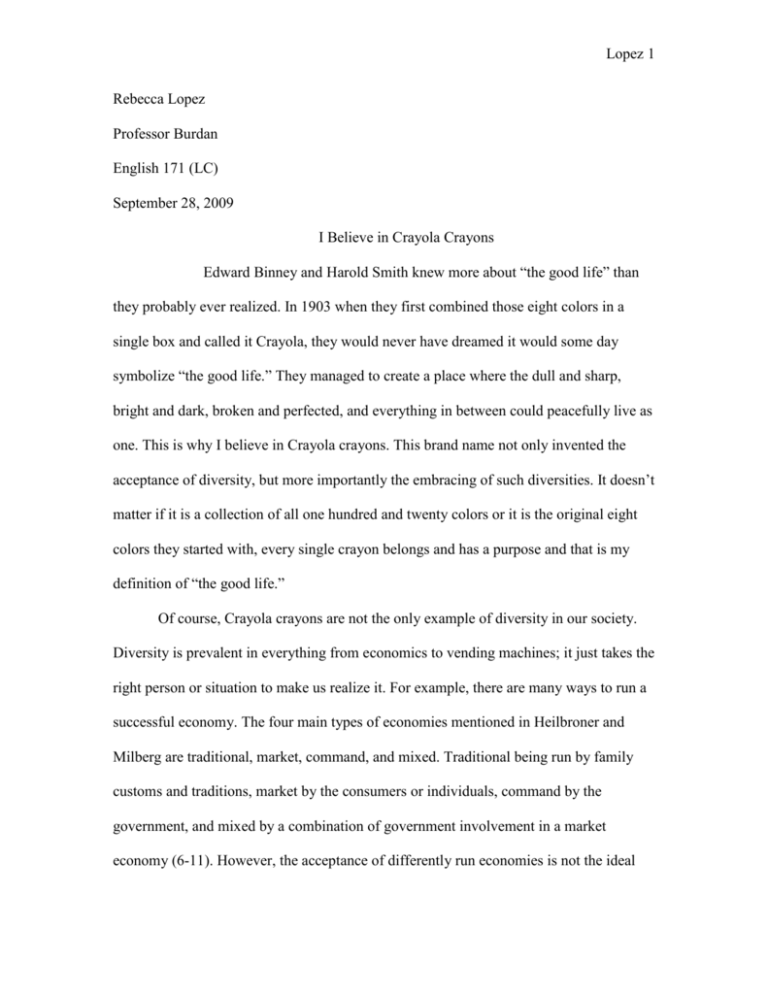
Lopez 1 Rebecca Lopez Professor Burdan English 171 (LC) September 28, 2009 I Believe in Crayola Crayons Edward Binney and Harold Smith knew more about “the good life” than they probably ever realized. In 1903 when they first combined those eight colors in a single box and called it Crayola, they would never have dreamed it would some day symbolize “the good life.” They managed to create a place where the dull and sharp, bright and dark, broken and perfected, and everything in between could peacefully live as one. This is why I believe in Crayola crayons. This brand name not only invented the acceptance of diversity, but more importantly the embracing of such diversities. It doesn’t matter if it is a collection of all one hundred and twenty colors or it is the original eight colors they started with, every single crayon belongs and has a purpose and that is my definition of “the good life.” Of course, Crayola crayons are not the only example of diversity in our society. Diversity is prevalent in everything from economics to vending machines; it just takes the right person or situation to make us realize it. For example, there are many ways to run a successful economy. The four main types of economies mentioned in Heilbroner and Milberg are traditional, market, command, and mixed. Traditional being run by family customs and traditions, market by the consumers or individuals, command by the government, and mixed by a combination of government involvement in a market economy (6-11). However, the acceptance of differently run economies is not the ideal Lopez 2 situation for “the good life.” The quintessential situation we strive for is the embracing of diversity in some aspect of the economy. This too, however, exists in the economy. The best example of embracing diversity in the economy is the division of labor because not only is diversity embraced in this situation, but more importantly it is necessary for the proper functioning of this labor force. Just as every person plays an individual and important role in the division of labor, Crayola crayons each serve their own purpose in the lovely world of colors; without one the group could not operate. In contrast to the successful outcomes of the embracing of diversity, there are also examples in society where the shunning of diversity leads to disaster and destruction. For example, in the Greek tragedy The Oresteia, written by Aeschylus, women were not seen as equals. They were torn down and treated like animals rather than human beings. Not only is this the complete opposite situation of that presented in “the good life,” but this suppression also leads to the destruction and downfall of the men in the play. Clytaemnestra ends up killing her own husband and suppressing her new significant other as a result of her built up anger throughout the years which is exemplified in her speech after she murders him: “Here he lies. He brutalized me. The darling of all the golden girls who spread the gates of Troy. And here his spear-prize…what wonders she beheld!- the seer of Apollo shared my husband’s bed, his faithful mate who knelt at the rowingbenches, worked by every hand. They have their rewards. He as you know. And she, the swan of the gods who lived to sing her latest, dying song- his lover lies beside him. She brings a fresh, voluptuous relish to my bed!(163)” In addition to expressing her own anger, Clytaemnestra is able to also show what purpose men saw in women; that of a slave-like lifestyle ruled by sex. Also, had Greece and Troy not begun to fight in this ten Lopez 3 year long war, then Clytaemnestra might not have been pushed over the edge. Therefore this exclusion of the more feminine colored crayons, or people of different genders, and the crayons located in the first row rather than the second, or people of different geographical locations, causes additional and unnecessary tension and death, both at home and during the war. Often times we can find examples in our everyday lives, in addition to examples in society, that work and don’t work. For instance, I was born and raised in Miami, Florida, where diversity is almost a way of life. I was surrounded by it twenty-four hours a day, seven days a week to the point that I did not even realize it anymore. However, when I moved to Troutman, North Carolina, at the age of sixteen, I began to acknowledge the fact that diversity is not seen as a positive everywhere. In fact, in some places, it is not seen at all. For example, in Miami I was one of ten Lopez’s in my freshman class. In Troutman, I was one of two in the entire school. The other was my younger brother. Simple aspects of life, such as grocery shopping, were also affected in our relocation to Troutman from Miami. For instance, my mother tends to make a lot of Hispanic dishes for our family, but once we were in Troutman the necessary ingredients were no longer available. Small towns, such as Troutman, just do not experience having different ethnicities within schools or grocery stores, but I believe this is detrimental to the education and development of the people living in such environments. Not only do they not become accustomed to diversity, so they can learn to appreciate and embrace it, but they also have fewer opportunities to learn something new about people of different heritages and lifestyles. Plus, the places in which diversity is shunned and disregarded often times Lopez 4 creates people who are ignorant and unable to move forward and improve. They fall into the habit of seeing the same people everyday for their entire lives, and although this may be comfortable for some people, breaking out of our shells is what allows us to learn to embrace diversity and finally live “the good life.” Therefore, just as the economy successfully embraces diversity and Greek tragedies do not, large cities, such as Miami, tend to embrace diversity more often than small towns, such as Troutman. Making Miami the crayon box that is full of every type and shade of crayon possible. While in the meantime, Troutman is selectively picking only the crayons that are identical or seem to “match” all the others, resulting in a monochromatic crayon box. On an even more personal level, diversity is prevalent within my heritage. Being both of Puerto Rican and Irish descent, I see diversity as both important and beneficial in life. Not only was I presented with more opportunities to learn to love diversity, but I was also introduced to two somewhat contrasting lifestyles. There are two different cultures, languages, traditions, religions, holidays, cuisines, and plenty more. For example, as a young child I stayed with my Puerto Rican grandparents, in addition to my Irish grandmother. This introduced me to both Spanish and English, Puerto Rican dishes and Irish dishes, Puerto Rican holidays and Irish holidays, and mainly the two different lifestyles led by each side of my family. I see this as a learning opportunity and try to take advantage of the fact that I have more chances to educate myself and become a more diverse person. Plus, the more crayons I have in my box, the more skills and knowledge I will have, in addition to the fact that more possibilities will open up for me in the future.


